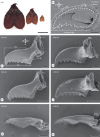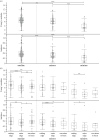Mandible elemental composition and mechanical properties from distinct castes of the leafcutter ant Atta laevigata (Attini; Formicidae)
- PMID: 38618230
- PMCID: PMC11008964
- DOI: 10.1098/rsfs.2023.0048
Mandible elemental composition and mechanical properties from distinct castes of the leafcutter ant Atta laevigata (Attini; Formicidae)
Abstract
Leafcutter ant colonies are divided into castes with the individuals performing different tasks, based mostly on size. With the mandibles, the small minims care for the brood or the fungus, whereas the larger minors and mediae cut and transport plant material, with the ant size positively related to the material size. The mechanical properties and composition of the mandible cuticle have been previously tested in the soldiers as the largest caste, revealing that the cutting edges contained high contents of the cross-linking transition metal zinc (Zn). With regard to the smaller castes, no data are present. To study how the mandible size and function relates to its mechanical properties, we here tested the mandibles of minims, minors and mediae by nanoindentation. We found that the hardness (H) and Young's modulus (E) values increased with increasing ant size and that the mandible cutting edges in each caste have the highest H- and E-values. To gain insight into the origins of these properties, we characterized the elemental composition by energy-dispersive X-ray analysis, revealing that minors and mediae possessed higher content of Zn in the cutting edges in contrast to the minims containing significantly less Zn. This shows, that Zn content relates to higher mechanical property values. Additionally, it shows that all of these parameters can differ within a single species.
Keywords: Young's modulus; biomechanics; cuticle; hardness; mouthparts; nanoindentation.
© 2024 The Authors.
Conflict of interest statement
We declare we have no competing interests.
Figures




References
-
- Wilson EO. 1987. Causes of ecological success: the case of the ants. J. Anim. Ecol. 56, 1-9. (10.2307/4795) - DOI
-
- Richter A, Hita Garcia F, Keller RA, Billen J, Economo EP, Beutel RG. 2020. Comparative analysis of worker head anatomy of Formica and Brachyponera (Hymenoptera: Formicidae). Arthropod Syst. Phyl. 78, 133-170.
-
- Barlow MM, Bicknell RDC, Andrew NR. 2020. Cuticular microstructure of Australian ant mandibles confirms common appendage construction. Acta. Zool. 101, 260-270. (10.1111/azo.12291) - DOI
-
- Chowdhury R, Rastogi N. 2021. Comparative analysis of mandible morphology in four ant species with different foraging and nesting habits. bioRxiv. (10.1101/2021.08.26.457866) - DOI
Associated data
LinkOut - more resources
Full Text Sources

